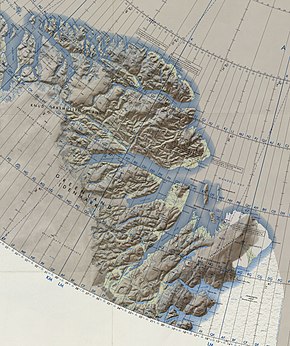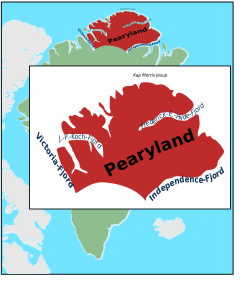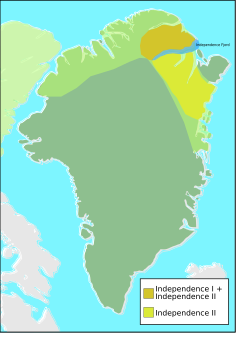Pearyland
| Pearyland | |
 MODIS satellite image of Pearyland |
|
| Geographical location | |
| Coordinates | 82 ° 30 ′ N , 35 ° 52 ′ W |
| Waters 1 | Victoriafjord / Wandelsee |
| Waters 2 | Independence Fjord / Lincolnsee |
| length | 375 km |
| width | 200 km |
| surface | 57,000 km² |
 Map of North Greenland with Pearyland |
|
Pearyland is a peninsula in northern Greenland that lies between Victoriafjord in the northwest and Independence Fjord in the southeast. The peninsula extends north into the Arctic Ocean , or in its parts, the Lincoln Sea in the west and the Wandel Sea in the east. The Victoriafjord separates the Pearyland from the neighboring Wulff Land to the southwest .
Pearyland is named after the polar explorer Robert Edwin Peary and is only 750 km south of the North Pole. The region in the north is called Amundsenland . Its northernmost point, Cape Morris Jesup , is the northernmost point on mainland Greenland. Off the coast are the islands of Kaffeklubben Island and Oodaaq , which are even further north.
Originally, Pearyland was thought to be an island, as it was assumed that there was a connection between Victoriafjord and Independence Fjord, known as the Peary Canal.
Landscape and climate
The Frederick E. Hyde Fjord, 150 km in length to the east of Pearyland, divides the area into northern and southern Pearyland, but is only one of many fjords that lie along the coast, including the J. P. Koch Fjord in the southwest. The entire area measures about 200 km in north-south direction and 375 km in east-west direction and covers an area of 57,000 km². It is not covered by the Greenland ice sheet . In the western part of Pearyland, however, there are several ice caps , of which the Hans-Tausen ice cap , which is up to 600 m thick, is the largest. The country is mountainous and reaches heights of up to 1,929 m in the Roosevelt Fjelde and up to 1,433 m in the HH Benedict Bjerge.
The eastern and northern Pearyland is largely ice-free, making it the northernmost, ice-free mainland in the world. During the last glacial period it was not covered by glaciers . With little precipitation (from 25 to 200 mm of snow per year) Pearyland is a cold desert , of which only about 5% are covered with a few plant species. Nevertheless, animal species such as the polar bear or the arctic wolf can survive in this climate .
To the southeast lies the Adam-Biering-Land .
history
The area north of Independence Fjord , especially the climatically favorable Wandeltal , shows numerous traces of human settlement from 2,400 BC to the 15th century AD. The southern Pearyland is the distribution center of two pre-Dorset cultures , the one after the fjord named Independence I and Independence II cultures.
Around 1300 the north of Pearyland and the rest of the north coast of Greenland were inhabited by representatives of the Thule culture . As a result of climatic deterioration, these people migrated to the southern coastal areas of Greenland within 200 years or, as in 1850, the Northeast Greenlanders became extinct, Pearyland has been uninhabited since then.
Qissivik was a settlement of the Thule culture, which was abandoned around the 14th century along with two neighboring settlements on Frigg Fjord , a northern branch of Frederick E. Hyde Fjord. These were the northernmost permanent settlements in human history.
In the course of the First Thule Expedition in 1912, it was established that Pearyland is not an island separated from Greenland by the hypothetical Peary Canal, but a peninsula. The remains of human dwellings found at Independence Fjord were further north than any known until then.
exploration
In Pearyland there are two arctic research stations at Jørgen-Brønlund-Fjord , Brønlundhus (built in 1948) and Cape Harald Moltke (built in 1972). Both stations were built on the initiative of Eigil Knuth and were the starting point for many scientific expeditions. The station Kap Harald Moltke was later built using a natural runway east of the mouth of the Jørgen-Brønlund-Fjord in the Independence-Fjord . The stations are 10 km apart. Brønlundhus is on the western side of the Jørgen-Brønlund-Fjord, and the connection between the two stations is maintained by boats in summer, as far as the ice conditions allow (mid-July to late August). Since the death of Eigil Knuth, the stations have been managed by the Peary Land Foundation . Today Brønlundhus can be seen as a museum, with a collection of items from various polar expeditions.
Ore mining
In 1993, extensive zinc and lead deposits were discovered in the northeast of Pearyland, by the Citronenfjord . They are considered to be the most abundant, unsupported zinc deposits in the world, and preparation is underway. The People's Republic of China is involved in mining projects in the Lemon Fjord.
literature
- Bjarne Grønnow, Jens Fog Jensen: The Northernmost Ruins of the Globe: Eigil Knuth's Archaeological Investigations in Peary Land and Adjacent Areas of High Arctic Greenland (PDF; 10.1 MB), Danish Polar Center, Copenhagen 2003, ISBN 978-87-635 -1262-6 (= Meddelelser om Grønland, Man & Society , Volume 29)
Web links
- Geological map of Greenland, section with Pearyland (Danish)
- Project for zinc and lead ore mining at Citronen-Fjord (2012) (English; archived)
- Nanok: The Peary Land Expedition 2001 (with photos of the stations)
Individual evidence
- ^ Lauge Koch: The Question of Peary Channel . In: Geographical Review 15, 1925, Issue 4, pp. 643–649 (English)
- ↑ Cape Harald Moltke and Brønlundhus at dpc.dk (archived)
- ↑ Niels Anner, Copenhagen: China has big plans in the Arctic | NZZ on Sunday . In: NZZ am Sonntag . ( nzz.ch [accessed on April 28, 2018]).


